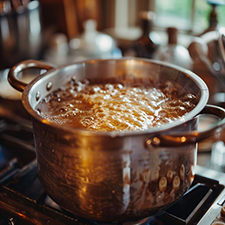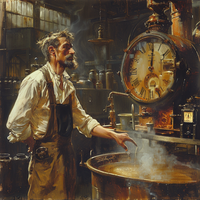The Art of the Boil: How Timing Can Make or Break Your Brew
Posted by Matteo Lahm on 31st Mar 2024
So, you've done your homework. You have the right grains, hops, and yeast all lined up, ready to create your next award-winning homebrew. But wait! Before you dive into the boiling pot, let's talk about something that's as crucial as the ingredients themselves: the boil time.
About 2/3 of beer recipes call for a 60-minute boil. You might be wondering, "What's the big deal and isn’t an hour kind of arbitrary?” What are the odds that the ideal boiling time for most beer styles coincidentally conforms to a standard unit of measurement invented 6000 years ago by the Ancient Sumerians? It may be coincidental after all and, perhaps experienced beer makers concluded it was a good approximate standard measurement. If nothing else, it’s easy to remember. Then if you ask, it's just boiling, right?" Well, it is not just boiling. It is a bit more complicated so let's break it down, shall we?

Boiling your wort is the rock concert for your beer. It's where all the energy happens. It's where your wort gets sanitized, concentrated, and flavored. It's where the proteins in your wort get together and form a mosh pit, dropping out of the solution and giving your beer that crystal-clear look. It's where your hops get their groove on, releasing their bitterness into the wort. And it's where complex flavors are born, thanks to the caramelization of sugars.
Now, you might be thinking, "Great! I'll just crank up the heat and let it boil for hours!" Hold your horses, cowboy. While a longer boil can be beneficial to certain beer styles, it is not beneficial to others. That it can lead to a higher alcohol content and more complex flavors might seem appealing at first, it can also darken your beer and potentially introduce off-flavors. You do not want a pale ale that is dark. It's a contradiction in terms. Remember, we're making beer here, not moonshine, or burnt toast.
Let’s flip the script and talk about a shorter boil. That is anything less than the standard 60 minutes. Now, you might be thinking, "Hey, I'm a busy person, I've got things to do, people to see. If I can shave off 15 or 30 minutes, why not?" Well, let's put it this way, it's like trying to bake a cake in half the time by doubling the oven temperature. Sure, it will be the shape of a cake, but it might be more like a semisoft brick.
Cutting the boil time can lead to a beer that's less stable, meaning it might not have the longevity you'd like. It could spoil faster or develop off-flavors over time. Additionally, the clarity of your beer could be compromised. It’s those proteins we talked about earlier. They need time to coagulate and drop out of the solution. Cut that time short, and they might just decide to hang out in your beer, leading to a cloudy appearance.
Now, let's talk about grains. Certain types, like pilsner malt, are high in S-methylmethionine (SMM), a compound that can lead to the production of Dimethyl Sulfide (DMS) during the boil. DMS is known for its distinct taste and aroma, often compared to creamed corn or cooked vegetables. Not exactly the flavor profile you want in your beer, right? To avoid this, a longer boil is needed to ensure all the SMM is evaporated from the boil pot.

So, while a shorter boil might seem tempting, it's important to consider the potential impact on your final product. Remember, good things come to those who wait, and that's especially true when it comes to brewing beer.
As for your ABV, that factors as well. You don’t want a beer that has too little or too much alcohol. You will lose about 1 gallon of water in a 60-minute boil. If you are making a 5-gallon batch, that is a lot. 15 minutes in either direction is a quart or about 5% of your total fluid volume. Alcohol levels are very touchy and just a little too much will mask some of your subtleties and too little will result in a flabby beer. You would do best to avoid either scenario.
So, what's the sweet spot? Well, the standard 60-minute boil seems to be the go-to for most homebrewers. It's long enough to get all the benefits of boiling, but not so long that you risk under or overdoing it. However, depending on the style of beer you're making and the ingredients you're using, you might need to adjust your boil time accordingly. A good recipe and a little knowledge can and will provide specifics.
For instance, if you're brewing a Double IPA, you might need a longer boil to achieve the right level of bitterness. And since IPA’s are generally higher in alcohol, that extra evaporation can be beneficial. But if you're making a light beer that doesn't require much caramelization, you might benefit from a shorter boil. Either way, if you intend to deviate from the 60-minute paradigm, you want to account for that when you measure your water. Recipes are specific to your desired finished volume and original specific gravity so you can accurately predict your ABV.
So now that everything regarding working with grains is clarified, let’s pivot to malt extracts. They have different rules because you're essentially using a shortcut. These extracts are made by taking malted grains and boiling them down into a concentrated syrup or powder. This process already includes the caramelization and hot break phases that you'd typically see in a traditional grain boil.
Caramelization, as you may recall, is the process where sugars are scorched during the boil, leading to a darker beer with complex flavors. The hot break, on the other hand, is when the proteins from the grain mashing coagulate and drop out of the solution, contributing to the final clarity of your beer. Since these processes have already occurred in the creation of the malt extract, you can significantly reduce your boil time.
However, there's a catch. You've got to be careful when adding these extracts to your boil. If you toss them in too early, they can sink to the bottom of your kettle and scorch, leading to burnt off-flavors in your beer. It's a bit like adding sugar to a hot pan - do it too soon, and you'll end up with a bitter, burnt mess.
So, the trick is to add your malt extracts towards the end of your boil. This allows them to dissolve into the hot water without the risk of scorching. It's a bit like adding the icing to a cake - you want to do it when the cake is still warm, but not straight out of the oven.
In a nutshell, using malt extracts can be a great time-saver in the brewing process, but it's important to handle them with care to ensure the best possible flavor in your final brew.
So, there you have it, folks. The art of the boil in a nutshell. Finding the perfect boil time might take some trial and error but experimentation is half the fun, right? Happy brewing!

